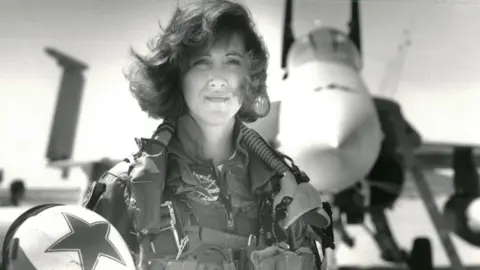Tammie Jo Shults: Southwest pilot praised for safe landing
 Reuters/US Navy
Reuters/US NavyA pilot who safely landed a Southwest Airlines passenger plane after a jet engine ripped apart mid-air has been praised as a hero by passengers.
A female passenger died after she was nearly sucked out of a shattered window of the stricken plane.
Tammie Jo Shults captained Flight 1380 to a Philadelphia airport in Tuesday's emergency, said passengers.
Survivors on the New York-to-Dallas flight carrying 149 people lauded the ex-US Navy pilot as an "American hero".
A cause has yet to be determined, but officials said an early review of the incident found evidence of metal fatigue where a fan blade had broken off, according to the US National Transportation Safety Board (NTSB).
Who is the pilot?
Capt Shults has not been officially named by Southwest Airlines, but passengers who were on the flight have identified her as the pilot. Her husband has also confirmed to the Associated Press that she was at the controls of the plane.
She was among the first cohort of female fighter pilots to transition to tactical aircraft, the US Navy has confirmed.
The New Mexico native graduated with university degrees in biology and agribusiness before joining the military.
Capt Shults served in the US Navy for 10 years and flew fighter jets before leaving active service in 1993 after achieving the rank of lieutenant commander.
Her husband, Dean Shults, is also a pilot for Southwest, says a relative.
On social media, some compared the mother-of-two with Captain Chesley "Sully" Sullenberger, who glided a US Airways plane into New York's main waterway in 2009 in what became known as "The Miracle on the Hudson".
What are passengers saying?
Passenger Alfred Tumlinson of Corpus Christi, Texas, praised the pilot for her "nerves of steel".
"That lady, I applaud her. I'm going to send her a Christmas card - I'm going to tell you that - with a gift certificate for getting me on the ground," he told the Associated Press.
Allow X content?

Diana McBride Self, who was also on the flight, posted a photo on Facebook of Capt Shults as she met passengers after the plane was back on the ground.
"Tammie Jo Schults, the pilot came back to speak to each of us personally. This is a true American Hero," she wrote.
"A huge thank you for her knowledge, guidance and bravery in a traumatic situation."
Allow Instagram content?

Who was the woman who died?

She was Jennifer Riordan, a 43-year-old mother-of-two and executive for Wells Fargo bank in Albuquerque, New Mexico.
Shrapnel from the shredded engine smashed a window and nearly sucked her out of the jet.
Other passengers pulled her back in and performed CPR to no avail.
Philadelphia's medical examiner said on Wednesday that she died of blunt impact trauma to her head, neck and torso.
Seven other passengers were slightly injured.
Ms Riordan is the first passenger to die in an accident on a US commercial airliner since 2009.

What happened on the flight?
About 20 minutes after the twin-engine Boeing 737 took off shrapnel pierced the passenger compartment causing the plane to lose pressure and rapidly drop.
With oxygen masks over their mouths, passengers screamed and braced for impact.
For a few seconds, the aircraft rolled to an angle of 41 degrees before levelling out and starting an emergency descent, federal investigators said on Wednesday.
"Southwest 1380, we're single engine," the pilot radioed to air traffic control.
"We have part of the aircraft missing so we're going to need to slow down a bit," she said, adding that some passengers had been hurt.
Allow Facebook content?

"Injured passengers, okay, and is your airplane physically on fire?" asks a male voice in the tower, according to a recording released by officials.
"No, it's not on fire, but part of it's missing," Capt Shults said.
"They said there's a hole, and uh, someone went out," she calmly says.
What have investigators said?
The chairman of the National Transportation Safety Board (NTSB) said early reports indicate one of the engine's 24 fan blades broke off due to metal fatigue while spinning at high speed.
"This fan blade was broken right at the hub. There is evidence of metal fatigue where the blade separated," Robert Sumwalt told reporters on Wednesday.
A casing on the engine is meant to contain any parts that come loose, but due to the speed, the metal was able to penetrate the shell, he added.
A piece was discovered about 60 miles (97km) northwest of Philadelphia on Tuesday, according to Mr Sumwalt.
US airline regulators said they would order inspections on engine fan blades like the one involved in this incident.
The engine was developed by French-US joint venture CFM International. French officials have said they are travelling to the US to aid in the investigation.
CFM say more than 8,000 of those engines are currently in use for Boeing 737 planes.
